

War on waste: Clothes swap and eco-styling workshops fighting the scourge of fast fashion. Posted It's a Sunday morning in a bright, airy space at a Canberra hotel and dozens of women are rifling through clothing racks and choosing their favourite pieces.
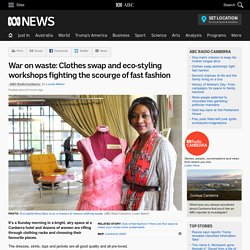
The dresses, skirts, tops and jackets are all good quality and all pre-loved. And the women — some op shop veterans, some novices — are all warriors in the war against fast fashion. Fast fashion is the term that describes the quick turnover of trendy, cheaply made clothing that often ends up in landfill. War on waste: Recycling denim into paper and fostering social inclusion in the process. Posted In a small studio in Canberra, artisans are recycling unwanted denim jeans and jackets by turning them into paper.
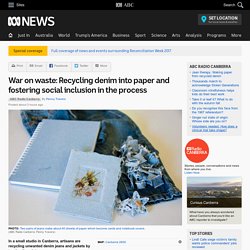
Paperworks is a not-for-profit social enterprise that uses the art of papermaking to engage marginalised people and those with special needs. "We were using cardboard and recycled paper in the first few sessions but it was unforgiving and had lacklustre results," chief executive Susanna Pieterse said. "We started looking into using textiles and became aware of the great need to recycle textiles — more than 80 per cent of denim actually ends up in landfill. "We found the longer fibres of textiles helped the paper hold together better. Rise of clothes swapping helps make a small dent in the war on fashion waste.
Posted Despite working in retail, Annelie Child decided that this year she was no longer going to buy new clothes.

Instead, she plans to only buy pre-loved or recycled wear by joining in the increasingly popular and frequent clothes-swapping events popping up around Sydney and around the country. "I've got an amazing wardrobe already, I don't really need anything else and I'm trying to back away from the fast fashion, buying news — there's no need," Ms Child said. "I was probably shopping more than I needed to and the wake-up call came when I bought a top and found something very similar in my wardrobe already. " Her first clothing swap event was at a pub in Sydney's inner west earlier this month with organisation The Clothing Exchange. She was one of 30 women who brought clothes to exchange for others for a participation fee of $25. Ms Child contributed two pairs of jeans, a dress and a jacket to the pool of clothes.
What Will it Take to Fix Unsustainable Fashion? British MP Mary Creagh - WARDROBE CRISIS with Clare Press. Why do we need to "fix" fashion?
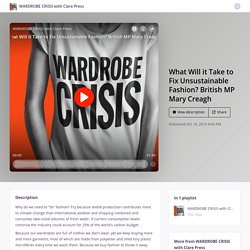
Try because textile production contributes more to climate change than international aviation and shipping combined and consumes lake-sized volumes of fresh water. If current consumption levels continue the industry could account for 25% of the world's carbon budget. Monsanto Loses Millions as Indian Cotton Farmers are Switching Back to Indigenous Seeds.
Monsanto is making the news these days for losing.
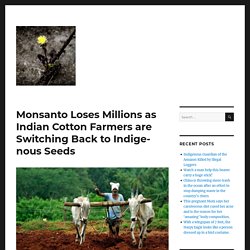
They have lost three court cases in which Roundup has been linked to cancer. In India, they are losing, too. After years of pushing a strain of Bt Cotton, Indian farmers have had enough and are switching back to native seeds for the cotton industry. The Adidas by Stella McCartney hoodie is made from old clothes. Unique, Stylish and Reusable baby products. 317d2d47 toxicthreads01.
Toxic Threads: The Big Fashion Stitch-Up. Greenpeace International has commissioned a new investigation that delves even further into the hazardous chemicals used in the production of high street fashion.
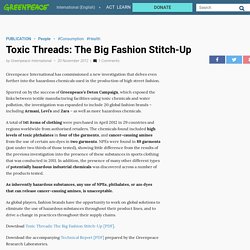
Spurred on by the success of Greenpeace’s Detox Campaign, which exposed the links between textile manufacturing facilities using toxic chemicals and water pollution, the investigation was expanded to include 20 global fashion brands – including Armani, Levi’s and Zara – as well as more hazardous chemicals. Greenpeace finds toxic chemicals in branded clothing. Traces of toxic chemicals harmful to the environment and to human health have been detected in products made by 14 top clothing manufacturers, Greenpeace said Tuesday.

Samples of clothing from top brands including Adidas, Uniqlo, Calvin Klein, H&M, Abercrombie & Fitch, Lacoste, Converse and Ralph Lauren were found to be tainted with the chemicals, known as nonylphenol ethoxylates, the watchdog said at the launch of its report "Dirty Laundry 2". Greenpeace campaigner Li Yifang said that nonylphenol ethoxylates (NPEs), commonly used as detergents in industries including the production of natural and synthetic textiles, were detected in two-thirds of the samples the group tested.
"NPEs break down to form nonylphenol, which has toxic, persistent and hormone-disrupting properties," Li told journalists in Beijing. Hazardous chemicals in clothing. Clothing and the Global Toxic Water Cycle Alkylphenols Commonly used alkylphenol compounds include nonylphenols (NPs) and octylphenols and their ethoxylates, particularly nonylphenol ethoxylates.
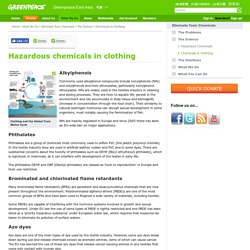
NPs are widely used in the textiles industry in cleaning and dyeing processes. They are toxic to aquatic life, persist in the environment and can accumulate in body tissue and biomagnify (increase in concentration through the food chain). Their similarity to natural oestrogen hormones can disrupt sexual development in some organisms, most notably causing the feminisation of fish. Does the Cora Ball capture plastic microfibres? - Face Down Waste. A couple of years ago, a Kickstarter project caught my attention.
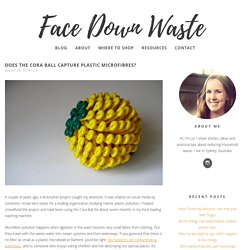
It was shared on social media by someone I know who works for a leading organisation studying marine plastic pollution. I helped crowdfund the project and have been using the Cora Ball for about seven months in my front loading washing machine. Environment-costs-fast-fashion-pollution-waste-sustainability-a8139386. It’s tough to love our clothes and keep wearing them for longer when we are faced with a tempting array of newness on offer in the shops.
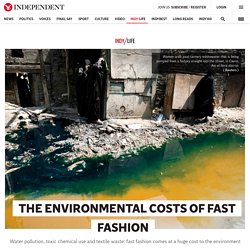
But before you head out into the January sales for those irresistible deals, spare a thought for the impact of fast fashion on the environment. Fast fashion focuses on speed and low costs in order to deliver frequent new collections inspired by catwalk looks or celebrity styles. But it is particularly bad for the environment, as pressure to reduce cost and the time it takes to get a product from design to shop floor means that environmental corners are more likely to be cut. Criticisms of fast fashion include its negative environmental impact, water pollution, the use of toxic chemicals and increasing levels of textile waste. Fast fashion is harming the planet, MPs say. Image copyright Getty Images Young people's love of fast fashion is coming under the scrutiny of Britain's law-makers. MPs say the fashion industry is a major source of the greenhouse gases that are overheating the planet. Discarded clothes are also piling up in landfill sites and fibre fragments are flowing into the sea when clothes are washed.
The retailers admit more needs to be done, but say they are already working to reduce the impact of their products. Great Barrier Reef's microfibre problem increasing due to synthetic clothes, study finds. Posted A survey of pollution on the Great Barrier Reef has found microfibres to be an increasing problem, making up nearly 70 per cent of samples collected. Zero waste daniel. Zero Waste Sewing. Zero waste fashion, zero waste design and zero waste sewing are all terms that have started to pop up more and more recently and it’s a topic that’s closely linked to my recent series on stash busting and carefully planned sewing versus rushed sewing that never gets worn.
What exactly is “zero waste sewing”? According to Wikipedia: Photographer Captures People With Every Single Piece Of Clothing They Own. According to the iconic phrase coined by the great American novelist, author of Fight Club, Chuck Palahniuk, and immortalized in pop culture by Brad Pitt, aka Tyler Durden, "the things you own end up owning you. " "You’re not your job. You’re not how much money you have in the bank.
You’re not the car you drive. You’re not the contents of your wallet. You’re not your fucking khakis. Eco-fashion’s Inconvenient Truth - About ethical clothing and sustainability. Issue: Fall 2017 Author: Alden Wicker Topics: Traditional Craftsmanship, Climate Change, Ecology, and Sustainability, Design, Fashion, and Lifestyle Materials: Plants, Cattle, Cotton, Plastic, Fabric, Leather, Trees, Fiber, Synthetics, Natural fibers, Chemicals, Worms, Animals In this exploration of the hidden stories behind materials such as wool and rayon, silk and polyester, and vegan leather, Alden Wicker—a frequent writer, blogger, and speaker on sustainable fashion—finds some inconvenient truths for the animal rights movement.
By ALDEN WICKER In the Guangdong region of China, a small company named Ziran makes a special silk, called xiang yun sha, through a process that has remained unchanged for 500 years. Ziran says all the resources used to make xiang yun sha come directly from mother nature: ''sun, earth, water.'' photo courtesy of Ziran Silk. 'Go forth and sparkle responsibly': How to have fun with glitter without damaging the environment. Opinion. Washing clothes releases thousands of microplastic particles into environment, study shows. More than 700,000 microscopic fibres could be released into waste water during each use of a domestic washing machine, with many of them likely to pass through sewage treatment and into the environment, according to new research. New Repair Café in Leytonstone attracts 200 customers on launch day. How to sew your own pockets and make your fast fashion more sustainable.
Posted If you're a lover of women's fashion, you may have a particular pet peeve which prompts the question: Where are the pockets? Core Crop - All Black. Fabric Scraps and Ways to Use Them: Fabric Scrap Projects. Fast Fashion Wrecks the Environment: Here Are 3 Ways to Slow It Down. By Gabriele Salari The fashion industry is considered to be one of the most polluting in the world. Boro: Japanese Folk Fabric.
After buying a boro scarf at a Tokyo flea market I wanted to learn more about the scruffy, stylish fabric. This lead to the unravelling of an interesting tale going back hundreds of years. 3 steps to start living your plastic-free, zero-waste life. The following is a guest post from Tammy Logan of Gippsland Unwrapped. She lives on a farm, is a mother, a passionate eco-warrior and has a degree in conservation biology. After completing Plastic Free July Tammy realised that she did have a choice about how she lived her life or voted with her dollar. Ties to Bind: Turn Neckties into Bias Binding. The seam allowances in this wool jacket were bound with multicolored silk from neckties.
Zero waste daniel. How to Responsibly Get Rid of Old Clothes — Selflessly Styled. I love a good closet purge. How our glitter obsession is wrecking the environment. Glitter is getting more and more popular by the day – illuminating Instagram and Facebook as it becomes the must-have finishing touch on looks for festivals, parties, and Pride. We’ve seen it used as makeup, dusted onto hair, and even slathered over beards (how could we forget that trend?!). Man slams bosses for telling him to take off his makeup at work. No-Sew Braided Leggings: 8 Steps (with Pictures) Creative Mending at The New Craftsmen.
June 21, 2017 by tomofholland I’m pleased to let you all know that I will be running a Creative Mending workshop at The New Craftsmen, on 22 July, as part of their summer exhibition Animal, Vegetable, Mineral – a joyful celebration of new talents and new pieces. Know Your Materials: What Each One Means for Sustainable Fashion. Kimono Wedding Dress Line Features Gowns Made from Antique Kimonos. Kalopsia Collective War on waste: How a capsule wardrobe could help you break your mindless shopping habit. War on waste: Recycling denim into paper and fostering social inclusion in the process. The Un-Material Girl: A fast fashion addict who's become an upcycling activist. Nike Reuse-A-Shoe FAQs. Zara and H&M back in-store recycling to tackle throwaway culture.
Why India Doesn’t Need The Sanitary Napkin Revolution. War on waste: Meet the home sewers saying no to fast fashion by making their own clothes. Microfibres: Scientists warn of growing cost of inaction on tiny particles polluting oceans. Rise of clothes swapping helps make a small dent in the war on fashion waste. Australian Fashion Week: Designers must focus more on sustainability, eco-fashionistas say. War on waste: The family of four producing half a bread bag of rubbish a week. Eleven hazardous chemicals which should be eliminated. Our Focus: War on Waste - ABC. Home - TRAID. Want to teach ethical fashion to kids? Here's how.
Green is the new black: Looking good can be extremely bad for the planet. 15 Ways to Stop Microfiber Pollution Now — Plastic Pollution Coalition. Ten Australian Sustainable Fashion Brands to Look Out For - tortoise & lady grey. Fast fashion: Rivers turning blue and 500,000 tonnes in landfill. Creative over capital: How you can gain some coin by getting inventive. Commercial Pattern Archive - FAQ. Communities – Boomerang Bags. TerraCycle. Recycled Footwear Fever - Developments in Shoe Materials. Demodé - bernarditamarambio. Fast fashion: International chains turn to green initiatives as alternative labels pop up. Why Are You Wearing Dirty Oil? Exciting Breakthrough In Recycled Cotton Fabric. Zero Waste Skirt Tutorial. Thread Raises $3.5M to Scale Transformation of Trash Into Dignified Jobs, Useful Products. Not So Fast (Fashion)! African Countries to Ban Secondhand Clothing Imports. Patagonia: Synthetic Fleece—Including Its Own—is Polluting the Oceans.
Mend it May. Know Your Materials: What Each One Means for Sustainable Fashion. Two threads - OUR STORY. The Most Rubbish Fun You'll Have + A Very Special Giveaway. Visible Mending as an art form. — The Craft Sessions. Guide To Second Hand Shopping And Hidden Gems. Plastic Pollution In The Sea From Your Clothing! What is the ECO PASSPORT By OEKO-TEX ? Fashioning Old into New Dyeing Fabric with Fruit Recycled Polyester The Hottest New (Old) Trend! Bio pigments: The Future Of Eco Dyeing. Plastic Wrap Alternatives & How To Make Cotton Beeswax Wraps. Plastic Wrap Alternatives & How To Make Cotton Beeswax Wraps. Maja Stabel. Home. How to Build a Sustainable Fashion Business - Creative Skillset. Home - Global Sisters. Ethical Fashion Forum. Outsmart Waste. ‘Human Resources’: Reality TV About a Recycling Company.
There is more to closed-loop textile recycling than technological innovation. Toxic fashion. The Future of Fashion Fabrics – Reducing Environmental Impact. DIY Eco Makeup Remover And Reuseble Pads. Social Alterations. Closing the loop on textile pollution. Recycled Yarns Saving Lives. MATERIALBYPRODUCT. Timo Rissanen. The True Cost (2015) Full Movie - Genvideos.